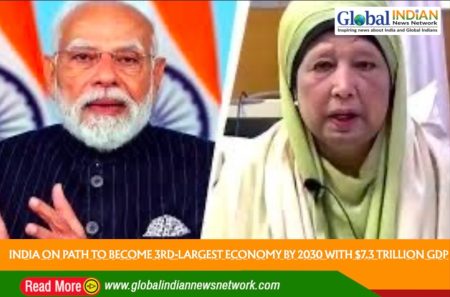 India’s Chandrayaan-3 mission aims to become the fourth country to execute a controlled landing on the moon. The mission successfully launched from the Satish Dhawan Space Center in Andhra Pradesh, with a large crowd witnessing the historic event. Over a million people also tuned in on YouTube to watch the launch. The Indian Space Research Organization (ISRO) confirmed on Twitter that Chandrayaan-3 is in a “precise orbit” and has begun its journey to the moon, with the spacecraft’s health reported as normal. Indian Prime Minister Narendra Modi expressed his admiration for the scientists’ dedication and hailed Chandrayaan-3 as a new chapter in India’s space exploration.
India’s Chandrayaan-3 mission aims to become the fourth country to execute a controlled landing on the moon. The mission successfully launched from the Satish Dhawan Space Center in Andhra Pradesh, with a large crowd witnessing the historic event. Over a million people also tuned in on YouTube to watch the launch. The Indian Space Research Organization (ISRO) confirmed on Twitter that Chandrayaan-3 is in a “precise orbit” and has begun its journey to the moon, with the spacecraft’s health reported as normal. Indian Prime Minister Narendra Modi expressed his admiration for the scientists’ dedication and hailed Chandrayaan-3 as a new chapter in India’s space exploration.
Chandrayaan-3 is expected to land on the moon’s surface on August 23. This is India’s second attempt at a soft landing, following the unsuccessful Chandrayaan-2 mission in 2019. The spacecraft, developed by ISRO, consists of a lander, propulsion module, and rover. Its main objective is to safely land on the lunar surface, gather data, and conduct scientific experiments to enhance our understanding of the moon’s composition. Soft-landing a spacecraft on the moon has only been achieved by three other countries: the United States, Russia, and China.
Indian engineers have been dedicatedly working on the mission for several years. Their goal is to land Chandrayaan-3 near the challenging terrain of the moon’s unexplored South Pole. India’s first lunar mission, Chandrayaan-1, discovered water molecules on the moon’s surface, while Chandrayaan-2 successfully entered lunar orbit but faced a setback when its rover crash-landed. Both missions aimed to explore the moon’s South Pole.
Prime Minister Modi, despite the previous failure, praised the engineers and promised to continue India’s space program and ambitions. Prior to the launch, he declared that the day would be remembered as a significant milestone in India’s space sector. The mission has a budget of approximately $75 million, and Modi stated that the spacecraft will cover a distance of over 300,000 kilometers (186,411 miles) to reach the moon in the coming weeks.
India’s space program has a rich history that dates back over six decades. Starting as a newly independent and economically challenged country, India has now become the world’s most populous nation and the fifth largest economy. Under Modi’s leadership, India has been actively pursuing its space ambitions to symbolize its rising prominence globally.
India achieved a major milestone in 2014 by becoming the first Asian nation to reach Mars with its Mangalyaan probe. The mission cost only $74 million, significantly less than the budget of the Hollywood film “Gravity.” In 2017, India launched a record-breaking 104 satellites in a single mission. The country also demonstrated its anti-satellite capabilities in 2019 by shooting down one of its own satellites, joining the exclusive group of nations with this capability.
The rapid progress and innovation in India’s space sector have attracted investments and attention from around the world. During Prime Minister Modi’s recent visit to the United States, discussions on collaboration in the space economy took place with President Joe Biden. India’s space ambitions extend beyond the moon and Mars, as ISRO has proposed sending an orbiter to Venus. This showcases India’s commitment to space exploration and technological advancements in this field.












